思科Nexus交换机-简介
- 格式:doc
- 大小:278.00 KB
- 文档页数:4
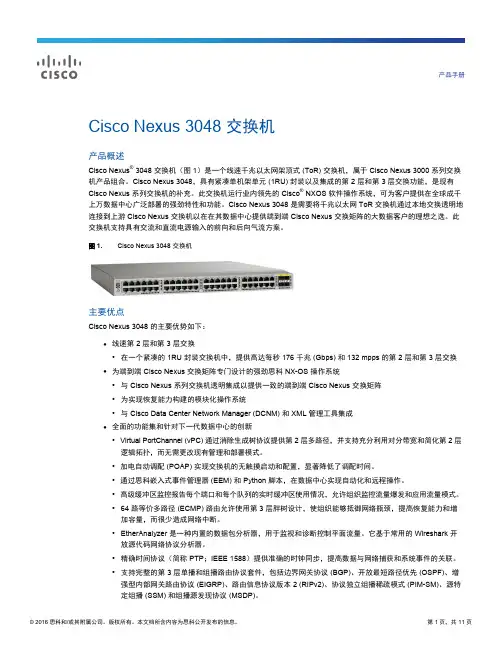
产品手册Cisco Nexus 3048 交换机产品概述Cisco Nexus® 3048 交换机(图 1)是一个线速千兆以太网架顶式 (ToR) 交换机,属于 Cisco Nexus 3000 系列交换机产品组合。
Cisco Nexus 3048,具有紧凑单机架单元 (1RU) 封装以及集成的第 2 层和第 3 层交换功能,是现有Cisco Nexus 系列交换机的补充。
此交换机运行业内领先的 Cisco® NXOS 软件操作系统,可为客户提供在全球成千上万数据中心广泛部署的强劲特性和功能。
Cisco Nexus 3048 是需要将千兆以太网 ToR 交换机通过本地交换透明地连接到上游 Cisco Nexus 交换机以在在其数据中心提供端到端 Cisco Nexus 交换矩阵的大数据客户的理想之选。
此交换机支持具有交流和直流电源输入的前向和后向气流方案。
图 1. Cisco Nexus 3048 交换机主要优点Cisco Nexus 3048 的主要优势如下:●线速第 2 层和第 3 层交换◦在一个紧凑的 1RU 封装交换机中,提供高达每秒 176 千兆 (Gbps) 和 132 mpps 的第 2 层和第 3 层交换●为端到端 Cisco Nexus 交换矩阵专门设计的强劲思科 NX-OS 操作系统◦与 Cisco Nexus 系列交换机透明集成以提供一致的端到端 Cisco Nexus 交换矩阵◦为实现恢复能力构建的模块化操作系统◦与 Cisco Data Center Network Manager (DCNM) 和 XML 管理工具集成●全面的功能集和针对下一代数据中心的创新◦Virtual PortChannel (vPC) 通过消除生成树协议提供第 2 层多路径,并支持充分利用对分带宽和简化第 2 层逻辑拓扑,而无需更改现有管理和部署模式。
◦加电自动调配 (POAP) 实现交换机的无触摸启动和配置,显著降低了调配时间。

产品手册Cisco Nexus 9200 平台交换机产品概述Cisco Nexus® 9200 平台是 Cisco Nexus 9000 系列交换机的最新成员。
Cisco Nexus 9200 平台由行业领先的超高密度固定配置数据中心交换机组成,具有线速第 2 层和第 3 层功能,可为企业应用、运营商托管和云计算环境提供支持。
此系列交换机外型紧凑,支持多种端口速度,可实现 1/10/25/40/50/100 Gbps 连接的灵活组合。
Nexus 9200 交换机采用广泛部署且行业领先的 Cisco® NX-OS 软件操作系统。
此交换机专为可编程的交换矩阵而设计,可为运营商和 IaaS/云提供商带来灵活性、移动性和可扩展性方面的优势,也能够为希望利用 DevOps 运营模式和工具集的客户提供具有自动化配置和管理功能的可编程网络。
型号表 1 汇总了 Cisco Nexus 9200 平台交换机的型号。
表 1.Cisco Nexus 9200 平台交换机*有关支持和端口配置的详细信息,请参阅表 2。
Cisco Nexus 92160YC-X 交换机(图 1)是一款单机架单元 (1RU) 交换机,带宽可达到 3.2 Tbps,吞吐量超过2.5 bpps。
92160YC-X 的 48 端口下行链路端口可配置为 1/10/25 Gbps 端口,从而为您提供部署灵活性和投资保护。
上行链路可以支持最多 4 个 100 Gbps 或最多 6 个 40 Gbps 端口,或 10、25、40 和 100 Gbps 的连接组合,从而为您提供灵活的迁移选项。
Cisco Nexus 92160YC-X 交换机让用户可以更好地了解其网络流量和遥感勘测数据。
有关所有支持的功能,请参阅此处提供的最新软件版本说明。
这个新功能不仅能帮助管理员改善网络操作,而且提供了丰富的数据资源来帮助改善网络基础设施,从而有效提高投资回报 (ROI)。
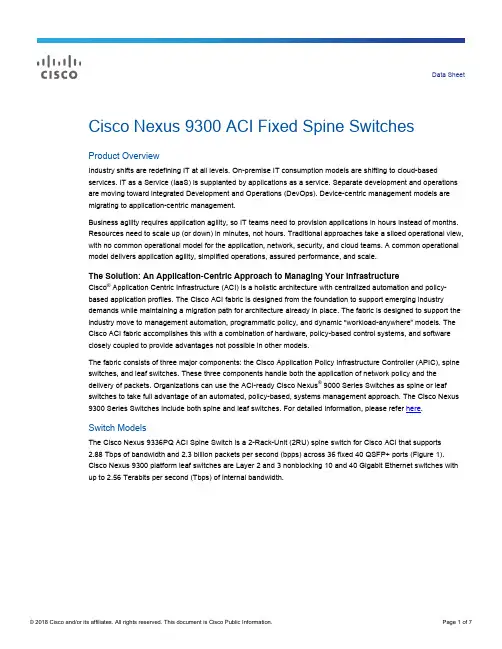
Data SheetCisco Nexus 9300 ACI Fixed Spine SwitchesProduct OverviewIndustry shifts are redefining IT at all levels. On-premise IT consumption models are shifting to cloud-based services. IT as a Service (IaaS) is supplanted by applications as a service. Separate development and operations are moving toward integrated Development and Operations (DevOps). Device-centric management models are migrating to application-centric management.Business agility requires application agility, so IT teams need to provision applications in hours instead of months. Resources need to scale up (or down) in minutes, not hours. Traditional approaches take a siloed operational view, with no common operational model for the application, network, security, and cloud teams. A common operational model delivers application agility, simplified operations, assured performance, and scale.The Solution: An Application-Centric Approach to Managing Your InfrastructureCisco® Application Centric Infrastructure (ACI) is a holistic architecture with centralized automation and policy-based application profiles. The Cisco ACI fabric is designed from the foundation to support emerging industry demands while maintaining a migration path for architecture already in place. The fabric is designed to support the industry move to management automation, programmatic policy, and dynamic “workload-anywhere” models. The Cisco ACI fabric accomplishes this with a combination of hardware, policy-based control systems, and software closely coupled to provide advantages not possible in other models.The fabric consists of three major components: the Cisco Application Policy Infrastructure Controller (APIC), spine switches, and leaf switches. These three components handle both the application of network policy and the delivery of packets. Organizations can use the ACI-ready Cisco Nexus® 9000 Series Switches as spine or leaf switches to take full advantage of an automated, policy-based, systems management approach. The Cisco Nexus 9300 Series Switches include both spine and leaf switches. For detailed information, please refer here.Switch ModelsThe Cisco Nexus 9336PQ ACI Spine Switch is a 2-Rack-Unit (2RU) spine switch for Cisco ACI that supports2.88 Tbps of bandwidth and 2.3 billion packets per second (bpps) across 36 fixed 40 QSFP+ ports (Figure 1). Cisco Nexus 9300 platform leaf switches are Layer 2 and 3 nonblocking 10 and 40 Gigabit Ethernet switches with up to 2.56 Terabits per second (Tbps) of internal bandwidth.Figure 1.Cisco Nexus 9336PQ SwitchThe Cisco Nexus 9364C ACI Spine Switch is a 2-Rack-Unit (2RU) spine switch for Cisco ACI that supports 12.84 Tbps of bandwidth and 4.3 bpps across 64 fixed 40/100G QSFP28 ports and 2 fixed 1/10G SFP+ ports(Figure 2). Breakout is not supported on ports 1 to 64. The last 16 ports marked in green support wire-rate MACsec encryption 1.Figure 2.Cisco Nexus 9364C SwitchThe Cisco Nexus 9332C is the smallest form-factor 1-Rack-Unit (1RU) spine switch for Cisco ACI that supports 6.4 Tbps of bandwidth and 2.3 bpps across 32 fixed 40/100G QSFP28 ports and 2 fixed 1/10G SFP+ ports(Figure 3). Breakout is not supported on ports 1 to 32. The last 8 ports marked in green support wire-rate MACsec encryption 2.Figure 3.Cisco Nexus 9332C SwitchSpecificationsTable 1 lists the specifications for the Cisco Nexus 9336PQ switch. (Please check Cisco ACI software release notes for feature support information.)Table 1.Cisco Nexus 9300 ACI Spine Switch Specifications1Software is expected in a future release. Please check the latest software update here . 2Software is expected in a future release. Please check the latest software update .●USB: 2 ports●RS-232 serial console ports: 1●Management ports: 1 x10/100/1000BASE-TPower and Cooling ●Power: 1200W AC, 930W DCor 1200W HVAC/HVDC●Input voltage: 100 to 240V*AC or -40V to -72V DC(min-max), -48V to -60V DC(nominal)*Supports input voltage of100-120V for a max output of800W; 200-240V for a maxoutput of 1200W●Frequency: 50 to 60 Hz (AC)●Efficiency: 90% or greater(20 to 100% load)●RoHS compliance: Yes●Hot swappable: Yes●Port-side intake or port-sideexhale options●Typical power: 400W (AC)●Maximum power: 660W (AC)●Power: 1200W AC, 930W DC3 or 1200WHVAC/HVDC●Input voltage: 100 to 240V* AC or -40V to-72V DC (min-max), -48V to -60V DC(nominal)*Supports input voltage of 100-120V for amax output of 800W; 200-240V for a maxoutput of 1200W; PSU redundancy is notsupported when used in 100-120V●Frequency: 50 to 60 Hz (AC)●Efficiency: 90% or greater (20 to 100%load)●RoHS compliance: Yes●Hot swappable: Yes●Port-side intake or port-side exhaleoptions●Typical power: 429W (AC)●Maximum power: 1245W (AC)●Power: 1100W AC, 1100 DC or 1100WHVAC/HVDC●Input voltage: 100 to 240V* AC or -40V to -72V DC (min-max), -48V to -60V DC(nominal)*Supports input voltage of 100-120V for amax output of 800W; 200-240V for a maxoutput of 1200W●Frequency: 50 to 60 Hz (AC)●Efficiency: 90% or greater(20 to 100% load)●RoHS compliance: Yes●Hot swappable: Yes●Port-side intake or port-side exhale options●Typical power: 296W (AC)●Maximum power: 700W (AC)Environme ntal ●Physical (H x W x D): 3.5 x17.5 x 22.5 in. (8.9 x 44.5 x57.1 cm)●Weight: 34.4 lb●Operating temperature: 32 to104°F (0 to 40°C)●Nonoperating (storage)temperature: -40 to 158°F (-40to 70°C)●Humidity: 5 to 95%(noncondensing)●Altitude: 0 to 13,123 ft (0 to4000m)●Physical (H x W x D): 3.38 x 17.37 x22.27 in. (8.59 x 44.13 x 56.58 cm)●Weight: 36.9lb (16.74kg) with powersupplies and fans, 27.4 lb (12.43kg)without power supplies and fans●Operating temperature: 32 to 104°F (0 to40°C)●Nonoperating (storage) temperature: -40to 158°F(-40 to 70°C)●Humidity: 5 to 85% (noncondensing)●Altitude: 0 to 13,123 ft (0 to 4000m)●Physical (H x W x D): 1.7 x 17.3 x 22.9 in.(4.4 x 43.9 x 58.1 cm)●Weight: 25.1lb (11.4kg) with powersupplies and fans, 19 lb (8.6kg) withoutpower supplies and fans●Operating temperature: 32 to 104°F (0 to40°C)●Nonoperating (storage) temperature: -40 to158°F (-40 to 70°C)●Humidity: 5 to 85% (noncondensing)●Altitude: 0 to 13,123 ft (0 to 4000m)Acoustics ●Fan speed at 40%: 64.4 dBA●Fan speed at 70%: 79.6 dBA●Fan speed at 100%: 89.8 dBA ●Fan speed at 40%: 76.7 dBA●Fan speed at 70%: 88.7 dBA●Fan speed at 100%: 97.4 dBA●Fan speed at 50%: 76.4 dBA●Fan speed at 70%: 83.3 dBA●Fan speed at 100%: 92.1 dBAMTBF ●242,000 hours ●257,860 hours ●363,500 hours3 930W-DC PSU is supported in redundancy mode if 3.5W QSFP+ modules or Passive QSFP cables are used & the system is used in 40C ambient temp or less; for other optics or higher ambient temps, 930W-DC is suppor ted with 2 PSU’s innon-redundancy mode only.Cisco Nexus 9300 ACI Spine Switch Deployment ScenariosThe Nexus 9300 ACI spine switch along with Nexus 9300 leaf nodes enable an automated and policy driven ACI architecture. The Cisco Nexus 9300 ACI spine switch offers advanced scalability in the smallest spine switch form factor, and enables connectivity to up-to 64 Cisco Nexus 9300 leaf switches with its high port density of 64 40/100 GbE ports and 12.84 Tbps throughput. The degree of redundancy in leaf-and-spine architectures delivers increased availability with a high level of flexibility in workload placement (Figure 3).Figure 4. Cisco Nexus 9300 Platform in a Leaf-and-Spine ArchitectureSoftware RequirementsFor the latest software release information and recommendations, please refer to the product bulletin athttps:///go/aci and Cisco Feature Navigator.Regulatory Standards ComplianceTable 2 summarizes regulatory standards compliance for the Cisco Nexus 9300 Spine switch.Table 2. Regulatory Standards Compliance: Safety and EMCSupported Optics PluggableFor details on the optical modules available and the minimum software release required for each supported optical module, visithttps:///en/US/products/hw/modules/ps5455/products_device_support_tables_list.html. Ordering InformationTable 3 presents ordering information for the Cisco Nexus 9300 ACI Spine Switch.Table 3. Ordering InformationWarrantyThe Cisco Nexus 9300 switch has a 1-year limited hardware warranty. The warranty includes hardware replacement with a 10-day turnaround from receipt of a Return Materials Authorization (RMA).Service and SupportCisco offers a wide range of services to help accelerate your success in deploying and optimizing the Cisco Nexus 9300 switch in your data center. The innovative Cisco Services offerings are delivered through a unique combination of people, processes, tools, and partners and are focused on helping you increase operation efficiency and improve your data center network. Cisco Advanced Services uses an architecture-led approach to help you align your data center infrastructure with your business goals and achieve long-term value. Cisco SMARTnet®Service helps you resolve mission-critical problems with direct access at any time to Cisco network experts and award-winning resources.Cisco CapitalFlexible payment solutions to help you achieve your objectives.Cisco Capital makes it easier to get the right technology to achieve your objectives, enable business transformation and help you stay competitive. We can help you reduce the total cost of ownership, conserve capital, and accelerate growth. In more than 100 countries, our flexible payment solutions can help you acquire hardware, software, services and complementary third-party equipment in easy, predictable payments. Learn more.For More InformationFor more information on the Cisco Nexus 9000 Series and for latest software release information and recommendations, please visit https:///go/nexus9000.。
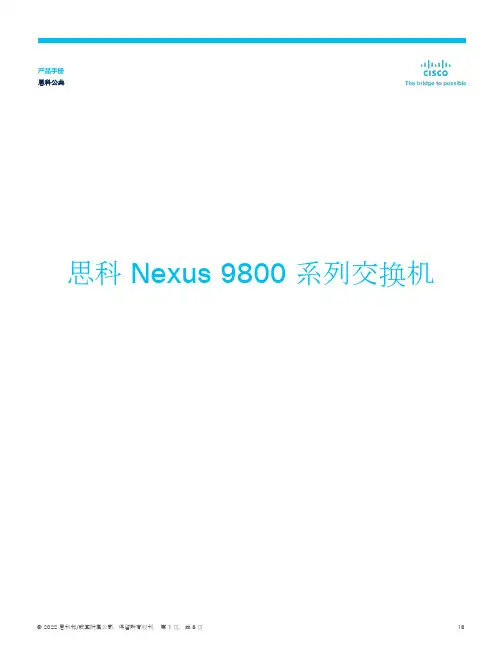
思科 Nexus 9800 系列交换机产品手册 思科公共Contents产品概述 (3)突出特点 (5)许可 (6)产品可持续性 (6)产品规格 (6)订购信息 (7)思科融资租赁 (8)思科 Nexus ® 9800 系列交换机在机箱中提供高密度 400G 解决方案,专为未来向高密度800G 和更高速度的过渡而设计。
产品概述思科 Nexus 9800 系列模块化交换机通过支持极高端口密度的 400 千兆以太网线卡的新机箱扩展了思科 Nexus 9000 系列产品组合。
数据中心不断发展,以支持下一代应用,例如推动数据中心内流量大幅增长的机器学习。
为了支持这种增长,数据中心运营商需要紧凑、高容量、高速且高效的交换机。
通过结合使用各种第一代线卡和交换矩阵模块,思科 Nexus 9800 系列机箱架构可以从 57 Tbps 扩展到 115 Tbps。
机箱中的每个线卡插槽均可支持提供 400GE 或 100GE 或 10/25/50GE 端口的线卡。
思科 Nexus 9800 系列机箱的设计是对上一代模块化机箱设计的重大改进,具有更好的配电和连接器、风扇和散热设计,使机箱将来能够扩展到更高的以太网速度线卡和交换矩阵模块。
这些设计原则允许使用下一代线卡和交换矩阵模块将总系统容量增加一倍,以与当前一代线卡相同的每个插槽的端口密度支持更高速度的端口(例如 800G)。
思科 Nexus 9800 系列交换机线卡和交换矩阵模块采用节能、高性能和高容量 ASIC 构建,支持动态流负载均衡、完全共享的片上数据包缓冲区以及小数据包的线速性能。
ASIC 提供这些功能,而不会影响功能和电源效率,并使思科Nexus 9800 系列交换机能够进行优化,以支持各种规模和规模的数据中心的高带宽应用。
此外,机箱架构支持双管理引擎控制平面冗余、最多八个交换矩阵模块的数据平面冗余、四个风扇托架的风扇托架冗余以及最多 12 个高效电源的电源冗余。
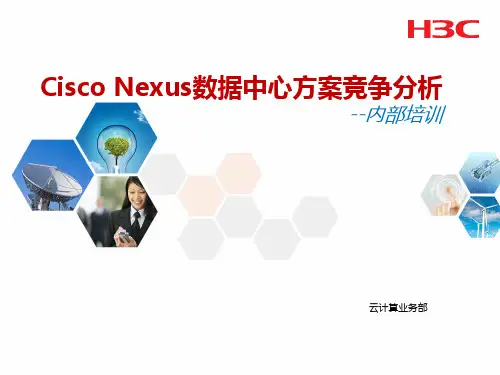
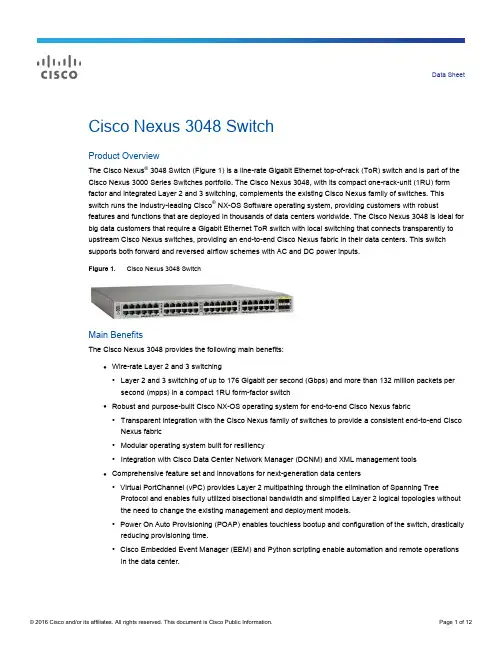
Data SheetCisco Nexus 3048 SwitchProduct OverviewThe Cisco Nexus® 3048 Switch (Figure 1) is a line-rate Gigabit Ethernet top-of-rack (ToR) switch and is part of the Cisco Nexus 3000 Series Switches portfolio. The Cisco Nexus 3048, with its compact one-rack-unit (1RU) form factor and integrated Layer 2 and 3 switching, complements the existing Cisco Nexus family of switches. This switch runs the industry-leading Cisco® NX-OS Software operating system, providing customers with robust features and functions that are deployed in thousands of data centers worldwide. The Cisco Nexus 3048 is ideal for big data customers that require a Gigabit Ethernet ToR switch with local switching that connects transparently to upstream Cisco Nexus switches, providing an end-to-end Cisco Nexus fabric in their data centers. This switch supports both forward and reversed airflow schemes with AC and DC power inputs.Figure 1. Cisco Nexus 3048 SwitchMain BenefitsThe Cisco Nexus 3048 provides the following main benefits:●Wire-rate Layer 2 and 3 switching◦Layer 2 and 3 switching of up to 176 Gigabit per second (Gbps) and more than 132 million packets per second (mpps) in a compact 1RU form-factor switch●Robust and purpose-built Cisco NX-OS operating system for end-to-end Cisco Nexus fabric◦Transparent integration with the Cisco Nexus family of switches to provide a consistent end-to-end Cisco Nexus fabric◦Modular operating system built for resiliency◦Integration with Cisco Data Center Network Manager (DCNM) and XML management tools●Comprehensive feature set and innovations for next-generation data centers◦Virtual PortChannel (vPC) provides Layer 2 multipathing through the elimination of Spanning Tree Protocol and enables fully utilized bisectional bandwidth and simplified Layer 2 logical topologies without the need to change the existing management and deployment models.◦Power On Auto Provisioning (POAP) enables touchless bootup and configuration of the switch, drastically reducing provisioning time.◦Cisco Embedded Event Manager (EEM) and Python scripting enable automation and remote operations in the data center.◦Advanced buffer monitoring reports real-time buffer utilization per port and per queue, which allows organizations to monitor traffic bursts and application traffic patterns.◦The 64-way equal-cost multipath (ECMP) routing enables Layer 3 fat tree designs and allows organizations to prevent network bottlenecks, increase resiliency, and add capacity with little networkdisruption.◦EtherAnalyzer is a built-in packet analyzer for monitoring and troubleshooting control-plane traffic and is based on the popular Wireshark open source network protocol analyzer.◦Precision Time Protocol (PTP; IEEE 1588) provides accurate clock synchronization and improved data correlation with network captures and system events.◦Full Layer 3 unicast and multicast routing protocol suites are supported, including Border Gateway Protocol (BGP), Open Shortest Path First (OSPF), Enhanced Interior Gateway Routing Protocol(EIGRP), Routing Information Protocol Version 2 (RIPv2), Protocol Independent Multicast sparse mode (PIM-SM), Source-Specific Multicast (SSM), and Multicast Source Discovery Protocol (MSDP).●Network traffic monitoring with Cisco Nexus Data Broker◦Build simple, scalable and cost-effective network tap or Cisco Switched Port Analyzer (SPAN) aggregation for network traffic monitoring and analysis.Configuration●48 fixed 10/100/1000-Mbps Ethernet ports● 4 fixed Enhanced Small Form-Factor Pluggable (SFP+) ports●Locator LED●Dual redundant power supplies●Fan tray with redundant fans●Two 10/100/1000-Mbps management ports*●One RS-232 serial console port●One USB port●Locator LED and buttonSupport for both forward (port-side exhaust) and reversed (port-side intake) airflow schemes is available.Transceiver and Cabling OptionsFor uplink connectivity, the Cisco Nexus 3048 supports SFP+ direct-attach 10 Gigabit Ethernet copper, an innovative solution that integrates transceivers with Twinax cables into an energy-efficient and low-cost solution. For longer cable runs, multimode and single-mode optical SFP+ transceivers are supported. Table 1 lists the supported 10 Gigabit Ethernet transceiver options.Table 1. Cisco Nexus 3048 10 Gigabit Transceiver Support Matrix1* Only one Management port is enabled and active with no plan to enable both.For more information about the transceiver types, see/en/US/products/hw/modules/ps5455/prod_module_series_home.html.Cisco NX-OS Software OverviewCisco NX-OS is a data center-class operating system built with modularity, resiliency, and serviceability at its foundation. Cisco NX-OS helps ensure continuous availability and sets the standard for mission-critical data center environments. The self-healing and highly modular design of Cisco NX-OS makes zero-impact operations a reality and enables exceptional operation flexibility.Focused on the requirements of the data center, Cisco NX-OS provides a robust and comprehensive feature set that meets the networking requirements of present and future data centers. With an XML interface and a command-line interface (CLI) like that of Cisco IOS® Software, Cisco NX-OS provides state-of-the-art implementations of relevant networking standards as well as a variety of true data center-class Cisco innovations.Cisco NX-OS Software BenefitsTable 2 summarizes the benefits that Cisco NX-OS offers.Table 2. Benefits of Cisco NX-OS SoftwareCisco NX-OS Software Packages for Cisco Nexus 3048The Cisco NX-OS Software package for the Cisco Nexus 3048 offers flexibility and a comprehensive feature set along with consistency with Cisco Nexus access switches. The default system software has a comprehensive Layer 2 feature set with extensive security and management features. To enable Layer 3 IP unicast and multicast routing functions, additional licenses need to be installed. Table 3 lists the software licensing details.Table 3. Cisco NX-OS Software Package in the Cisco Nexus 3048* The Base license (N3K-C3048-BAS1K9) is required to take advantage of LAN Enterprise license (N3K-C3048-LAN1K9) features. Table 5 later in this document provides a complete feature list.Cisco Data Center Network ManagerThe Cisco Nexus 3048 is supported in Cisco DCNM. Cisco DCNM is designed for hardware platforms enabled for Cisco NX-OS, which consist of the Cisco Nexus Family of products. Cisco DCNM is a Cisco management solution that increases overall data center infrastructure uptime and reliability, hence improving business continuity. Focused on the management requirements of the data center network, Cisco DCNM provides a robust framework and comprehensive feature set that meets the routing, switching, and storage administration needs of present and future data centers. In particular, Cisco DCNM automates the provisioning process, proactively monitors the LAN by detecting performance degradation, secures the network, and streamlines the diagnosis of dysfunctional network elements.Cisco Nexus Data BrokerThe Cisco Nexus 3048 Switch with Cisco Nexus Data Broker can be used to build a scalable and cost-effective traffic monitoring infrastructure using network taps and SPAN. This approach replaces the traditional purpose-built matrix switches with one or more OpenFlow-enabled Cisco Nexus switches. You can interconnect these switches to build a scalable tap or SPAN aggregation infrastructure. You also can combine tap and SPAN sources to bring the copy of the production traffic to this tap or SPAN aggregation infrastructure. In addition, you can distribute these sources and traffic monitoring and analysis tools across multiple Cisco Nexus switches. For more details, visit /go/nexusdatabroker.Product SpecificationsTable 4 lists the specifications for the Cisco Nexus 3048, Table 5 lists software features, and Table 6 lists management standards and support.Table 4. Specifications* Please refer to Cisco Nexus 3000 Series Verified Scalability Guide for scalability numbers validated for specific software releases: /en/US/products/ps11541/products_installation_and_configuration_guides_list.html.Table 5. Software Features●HSRP and VRRP●ACL: Routed ACL with Layer 3 and 4 options to match ingress and egress ACLs●VRF: VRF-lite (IP VPN), VRF-aware unicast (BGP, OSPF, and RIP), and VRF-aware multicast●uRPF with ACL; strict and loose modes●Jumbo frame support (up to 9216 bytes)Multicast Multicast: PIM-SM Version 2 and SSMBootstrap router (BSR), Automatic Rendezvous Point (Auto-RP), and Static RPMSDP and Anycast-RPInternet Group Management Protocol (IGMP) Versions 2, and 3Quality of service (QoS) Layer 2 IEEE 802.1p (class of service [CoS])8 hardware queues per portPer-port QoS configurationCoS trustPort-based CoS assignmentModular QoS CLI (MQC) complianceACL-based QoS classification (Layers 2, 3, and 4)MQC CoS markingDifferentiated services code point (DSCP) markingWeighted Random Early Detection (WRED)CoS-based egress queuingEgress strict-priority queuingEgress port-based scheduling: Weighted Round-Robin (WRR)Explicit Congestion Notification (ECN)Security ●Ingress ACLs (standard and extended) on Ethernet●Standard and extended Layer 3 to 4 ACLs: IPv4, Internet Control Message Protocol (ICMP), TCP, UserDatagram Protocol (UDP), etc.●VLAN-based ACLs (VACLs)●Port-based ACLs (PACLs)●Named ACLs●ACLs on virtual terminals (vtys)●DHCP snooping with Option 82●Port number in DHCP Option 82●DHCP relay●Dynamic Address Resolution Protocol (ARP) inspection●CoPPCisco Nexus Data Broker ●Topology support for tap and SPAN aggregation●Support for QinQ to tag input source tap and SPAN ports●Traffic load balancing to multiple monitoring tools●Traffic filtering based on Layer 1 through Layer 4 header information●Traffic replication and forwarding to multiple monitoring tools●Robust RBAC●Northbound Representational State Transfer (REST) API for all programmability support Management ●Switch management using 10/100/1000-Mbps management or console ports●CLI-based console to provide detailed out-of-band management●In-band switch management●Locator and beacon LEDs●Port-based locator and beacon LEDs●Configuration rollback●SSHv2●Telnet●AAA●AAA with RBAC●RADIUS●TACACS+●SyslogTable 6. Management and Standards Support Description SpecificationMIB support Generic MIBs●SNMPv2-SMI●CISCO-SMI●SNMPv2-TM●SNMPv2-TC●IANA-ADDRESS-FAMILY-NUMBERS-MIB●IANAifType-MIB●IANAiprouteprotocol-MIB●HCNUM-TC●CISCO-TC●SNMPv2-MIB●SNMP-COMMUNITY-MIB●SNMP-FRAMEWORK-MIB●SNMP-NOTIFICATION-MIB●SNMP-TARGET-MIB●SNMP-USER-BASED-SM-MIB●SNMP-VIEW-BASED-ACM-MIB●CISCO-SNMP-VACM-EXT-MIBEthernet MIBs●CISCO-VLAN-MEMBERSHIP-MIB●LLDP-MIB●IP-MULTICAST-MIBConfiguration MIBs●ENTITY-MIB●IF-MIB●CISCO-ENTITY-EXT-MIB●CISCO-ENTITY-FRU-CONTROL-MIB●CISCO-ENTITY-SENSOR-MIB●CISCO-SYSTEM-MIB●CISCO-SYSTEM-EXT-MIB Monitoring MIBs●NOTIFICATION-LOG-MIB●CISCO-SYSLOG-EXT-MIB●CISCO-PROCESS-MIB●RMON-MIB●CISCO-RMON-CONFIG-MIB●CISCO-HC-ALARM-MIBSecurity MIBs●CISCO-AAA-SERVER-MIB●CISCO-AAA-SERVER-EXT-MIB ●CISCO-COMMON-ROLES-MIB●CISCO-COMMON-MGMT-MIB●CISCO-SECURE-SHELL-MIB Miscellaneous MIBs●CISCO-LICENSE-MGR-MIB●CISCO-FEATURE-CONTROL-MIB ●CISCO-CDP-MIB●CISCO-RF-MIBLayer 3 and Routing MIBs●UDP-MIB●TCP-MIB●OSPF-MIB●BGP4-MIB●CISCO-HSRP-MIB●CISCO-IP-IF-MIB●CISCO-IF-EXTENSION-MIB●CISCO-NTP-MIB●CISCO-IMAGE-MIB●CISCO-IMAGE-UPGRADE-MIBStandards ●IEEE 802.1D: Spanning Tree Protocol●IEEE 802.1p: CoS Prioritization●IEEE 802.1Q: VLAN Tagging●IEEE 802.1s: Multiple VLAN Instances of Spanning Tree Protocol●IEEE 802.1w: Rapid Reconfiguration of Spanning Tree Protocol●IEEE 802.3z: Gigabit Ethernet●IEEE 802.3ad: Link Aggregation Control Protocol (LACP)●IEEE 802.3ae: 10 Gigabit Ethernet●IEEE 802.1ab: LLDP●IEEE 1588-2008: Precision Time Protocol (Boundary Clock)RFC BGP●RFC 1997: BGP Communities Attribute●RFC 2385: Protection of BGP Sessions with the TCP MD5 Signature Option●RFC 2439: BGP Route Flap Damping●RFC 2519: A Framework for Inter-Domain Route Aggregation●RFC 2545: Use of BGPv4 Multiprotocol Extensions●RFC 2858: Multiprotocol Extensions for BGPv4●RFC 3065: Autonomous System Confederations for BGP●RFC 3392: Capabilities Advertisement with BGPv4●RFC 4271: BGPv4●RFC 4273: BGPv4 MIB: Definitions of Managed Objects for BGPv4●RFC 4456: BGP Route Reflection●RFC 4486: Subcodes for BGP Cease Notification Message●RFC 4724: Graceful Restart Mechanism for BGP●RFC 4893: BGP Support for Four-Octet AS Number SpaceOSPF●RFC 2328: OSPF Version 2●8431RFC 3101: OSPF Not-So-Stubby-Area (NSSA) Option●RFC 3137: OSPF Stub Router Advertisement●RFC 3509: Alternative Implementations of OSPF Area Border Routers●RFC 3623: Graceful OSPF Restart●RFC 4750: OSPF Version 2 MIBRIP●RFC 1724: RIPv2 MIB Extension●RFC 2082: RIPv2 MD5 Authentication●RFC 2453: RIP Version 2●IP Services●RFC 768: User Datagram Protocol (UDP)●RFC 783: Trivial File Transfer Protocol (TFTP)●RFC 791: IP●RFC 792: Internet Control Message Protocol (ICMP)●RFC 793: TCP●RFC 826: ARP●RFC 854: Telnet●RFC 959: FTP●RFC 1027: Proxy ARP●RFC 1305: Network Time Protocol (NTP) Version 3●RFC 1519: Classless Interdomain Routing (CIDR)●RFC 1542: BootP Relay●RFC 1591: Domain Name System (DNS) ClientSoftware RequirementsCisco Nexus 3000 Series Switches are supported by Cisco NX-OS Software Release 5.0 and later. Cisco NX-OS interoperates with any networking OS, including Cisco IOS Software, that conforms to the networking standards mentioned in this data sheet.Regulatory Standards ComplianceTable 7 summarizes regulatory standards compliance for the Cisco Nexus 3000 Series.Table 7. Regulatory Standards Compliance: Safety and EMCOrdering InformationTable 8 provides ordering information for the Cisco Nexus 3048. Table 8. Ordering InformationService and SupportCisco offers a wide range of services to help accelerate your success in deploying and optimizing the Cisco Nexus 3000 Series in your data center. The innovative Cisco Services offerings are delivered through a uniquecombination of people, processes, tools, and partners and are focused on helping you increase operation efficiency and improve your data center network. Cisco Advanced Services uses an architecture-led approach to help you align your data center infrastructure with your business goals and achieve long-term value. Cisco SMARTnet ® Service helps you resolve mission-critical problems with direct access at any time to Cisco network experts and award-winning resources. With this service, you can take advantage of the Cisco Smart Call Home service capability, which offers proactive diagnostics and real-time alerts on your Cisco Nexus 3000 Series Switches. Spanning the entire network lifecycle, Cisco Services helps increase investment protection, optimize network operations, support migration operations, and strengthen your IT expertise.For More InformationFor more information, please visit /go/nexus3000. For information about Cisco Nexus Data Broker, please visit /go/nexusdatabroker .Printed in USA C78-685363-0706/16。

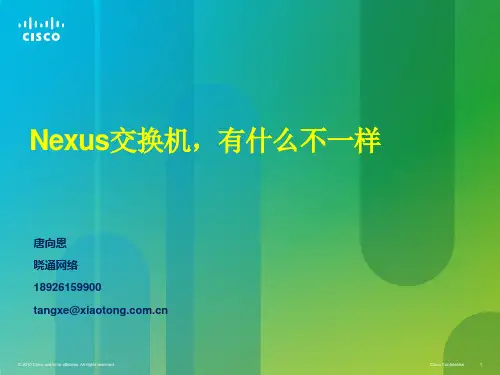
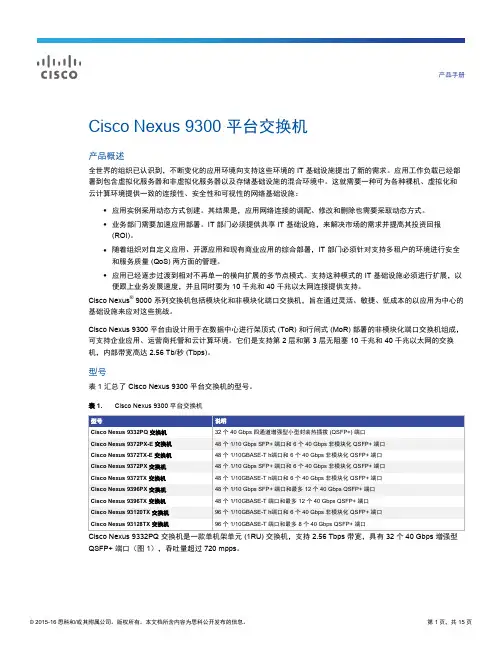
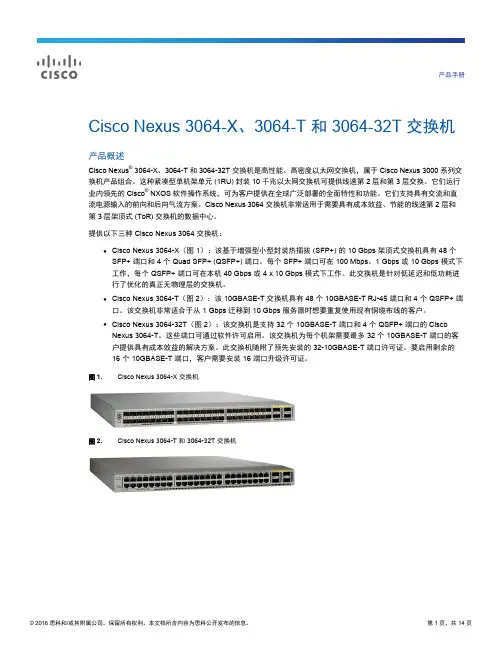
产品手册Cisco Nexus 3064-X、3064-T 和 3064-32T 交换机产品概述Cisco Nexus® 3064-X、3064-T 和 3064-32T 交换机是高性能、高密度以太网交换机,属于 Cisco Nexus 3000 系列交换机产品组合。
这种紧凑型单机架单元 (1RU) 封装 10 千兆以太网交换机可提供线速第 2 层和第 3 层交换。
它们运行业内领先的 Cisco® NXOS 软件操作系统,可为客户提供在全球广泛部署的全面特性和功能。
它们支持具有交流和直流电源输入的前向和后向气流方案。
Cisco Nexus 3064 交换机非常适用于需要具有成本效益、节能的线速第 2 层和第 3 层架顶式 (ToR) 交换机的数据中心。
提供以下三种 Cisco Nexus 3064 交换机:●Cisco Nexus 3064-X(图 1):该基于增强型小型封装热插拔 (SFP+) 的 10 Gbps 架顶式交换机具有 48 个SFP+ 端口和 4 个 Quad SFP+ (QSFP+) 端口。
每个 SFP+ 端口可在 100 Mbps、1 Gbps 或 10 Gbps 模式下工作,每个 QSFP+ 端口可在本机 40 Gbps 或 4 x 10 Gbps 模式下工作。
此交换机是针对低延迟和低功耗进行了优化的真正无物理层的交换机。
●Cisco Nexus 3064-T(图 2):该 10GBASE-T 交换机具有 48 个 10GBASE-T RJ-45 端口和 4 个 QSFP+ 端口。
该交换机非常适合于从 1 Gbps 迁移到 10 Gbps 服务器时想要重复使用现有铜缆布线的客户。
●Cisco Nexus 3064-32T(图 2):该交换机是支持 32 个 10GBASE-T 端口和 4 个 QSFP+ 端口的 CiscoNexus 3064-T。
这些端口可通过软件许可启用。
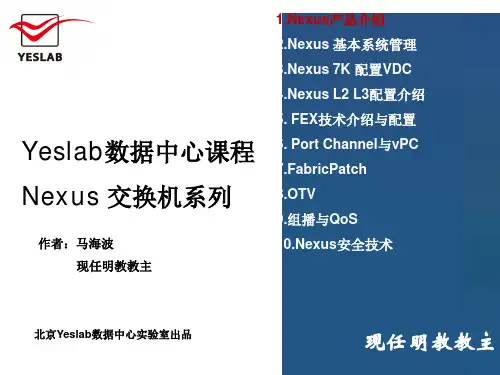
Data Sheet Cisco Nexus 3132Q, 3132Q-X, and 3132Q-XL SwitchesProduct OverviewThe Cisco Nexus® 3132Q, 3132Q-X, and 3132Q-XL Switches are dense, high-performance, 40-Gbps Layer 2 and 3 switches. They are members of the Cisco Nexus 3100 platform. These second-generation Cisco Nexus 3000 Series Switches offer improved port density, scalability, and features compared to the first-generation switches. The Cisco Nexus 3132Q, 3132Q-X, and 3132Q-XL come in a compact one-rack-unit (1RU) form factor and run the industry-leading Cisco® NX-OS Software operating system, providing customers with comprehensive features and functions that are widely deployed. They support both forward and reverse airflow (port-side exhaust and port-side intake) schemes with AC and DC power inputs. The Cisco Nexus 3132 are well suited for data centers that require a cost-effective, power-efficient line-rate Layer 2 and 3 access or leaf switch.Three Cisco Nexus 3132 switches are available:●The Cisco Nexus 3132Q (Figure 1) is a 40-Gbps Quad Small Form-Factor Pluggable (QSFP) switch with 32Enhanced QSFP (QSFP+) ports. It also has 4 SFP+ ports that are internally multiplexed with the first QSFP port. Each QSFP+ port can operate in native 40-Gbps or 4 x 10-Gbps mode, with up to a maximum of 104 x 10-Gbps ports.Figure 1. Cisco Nexus 3132Q Switch●The Cisco Nexus 3132Q-X (Figure 2) is a minor hardware revision of the Cisco Nexus 3132Q.Enhancements include the removal of retimers, a different port layout, and the addition of an LED laneselector. The Cisco Nexus 3132Q-X also consumes 40 watts (W) less power than the Cisco Nexus 3132Q and has increased CPU performance.Figure 2. Cisco Nexus 3132Q-X Switch●The Cisco Nexus 3132Q-XL (Figure 3) is a minor hardware revision of the Cisco Nexus 3132Q-X.Enhancements include an additional 4 GB of memory (for a total of 8 GB). The Cisco Nexus 3132Q-XL also has a 16GB of Logflash and 2.5-GHz CPU.Figure 3. Cisco Nexus 3132Q-XL SwitchMain BenefitsThe Cisco Nexus 3132Q, 3132Q-X, and 3132Q-XL provide the following main benefits:●Wire-rate Layer 2 and 3 switching on all ports1◦Layer 2 and 3 switching of up to 2.5 terabits per second (Tbps) and up to 1.4 billion packets per second (bpps) is provided in a compact 1RU form-factor switch.●High availability◦Virtual-port-channel (vPC) technology provides Layer 2 multipathing through the elimination of Spanning Tree Protocol and enables fully utilized bisectional bandwidth and simplified Layer 2 logical topologieswithout the need to change the existing management and deployment models.◦The 64-way equal-cost multipath (ECMP) routing enables the use of Layer 3 fat-tree designs and allows organizations to prevent network bottlenecks, increase resiliency, and add capacity with little networkdisruption.◦The switches offer fast reboot capabilities.◦Power-supply units (PSUs) and fans are hot swappable.●Flexibility◦The QSFP port can be configured to work as four 10-Gbps ports, offering deployment flexibility with maximum of 104 x 10-Gbps ports.●High performance◦Both switches deliver low nominal latency, which enables customers to implement high-performance infrastructure for high-frequency trading (HFT) workloads. Customers can also achieve faster application performance because of the serialization savings from switching at 40 Gigabit Ethernet speeds.●Purpose-built NX-OS operating system with comprehensive, proven innovations◦Power-on auto provisioning (POAP) enables touchless bootup and configuration of the switch, drastically reducing provisioning time.◦Cisco Embedded Event Manager (EEM) and Python scripting enable automation and remote operations in the data center.◦Advanced buffer monitoring reports real-time buffer utilization per port and per queue, which allows organizations to monitor traffic bursts and application traffic patterns.◦EtherAnalyzer is a built-in packet analyzer for monitoring and troubleshooting control-plane traffic and is based on the popular Wireshark open-source network protocol analyzer.◦Precision Time Protocol (PTP; IEEE 1588) provides accurate clock synchronization and improved data correlation with network packet capture and system events.1 Wire rate on all ports for packets greater than 200 bytes◦Complete Layer 3 unicast and multicast routing protocol suites are supported, including Border Gateway Protocol (BGP), Open Shortest Path First (OSPF), Enhanced Interior Gateway Routing Protocol (EIGRP), Routing Information Protocol Version 2 (RIPv2), Protocol-Independent Multicast sparse mode (PIM-SM), Source-Specific Multicast (SSM), and Multicast Source Discovery Protocol (MSDP).ConfigurationAll three switches have the following configuration:●32 fixed 40 Gigabit Ethernet QSFP+ ports● 4 SFP+ ports, which are multiplexed internally with the first QSFP+ port●Locator LED●Dual redundant power supplies●Redundant (3+1) fans●Support for forward (port-side exhaust) and reversed (port-side intake) airflow schemesThe Cisco Nexus 3132Q has the following configuration:●One 10/100/1000-Mbps management port located on the front of the chassis●One RS-232 serial console port located on the front of the chassis●One USB port located on the front of the chassisThe Cisco Nexus 3132Q-X has the following configuration:●Lane selector button and LED●One 10/100/1000-Mbps management port located on the rear of the chassis●One RS-232 serial console port on located on the rear of the chassis●One USB port located on the rear of the chassisThe Cisco Nexus 3132Q-XL has the following configuration:●8 GB of memory and 2.5-GHz CPU●Lane selector button and LED●One 10/100/1000-Mbps management port located on the rear of the chassis●One RS-232 serial console port located on the rear of the chassis●One USB port located on the rear of the chassisTransceiver and Cabling OptionsThe Cisco Nexus 3132Q, 3132Q-X, and 3132Q-XL have 32 QSFP+ ports. QSFP+ technology allows a smooth transition from 10 to 40 Gigabit Ethernet infrastructure in data centers. Each of the switches’ QSFP+ ports can operate in either native 40 Gigabit Ethernet mode or 4 x 10 Gigabit Ethernet mode. All switches support both fiber and copper cabling solutions for these two modes.For low-cost cabling, copper-based 40-Gbps Twinax cables can be used, and for longer cable reaches, short-reach optical transceivers are excellent. Connectivity can be established from the QSFP+ ports to 10 Gigabit Ethernet switches or hosts using a splitter cable that has a QSFP+ transceiver on one end and four SFP+ transceivers on the other end. Similar capability can be achieved on the fiber solution by using QSFP+ SR4 transceivers on both ends and procuring third-party fiber splitter MPO-to-LC cables.For details about the optics modules available and the minimum software release required for each supported optics module, visitFor more information about the transceiver types, see/en/US/products/hw/modules/ps5455/prod_module_series_home.html.Cisco NX-OS Software OverviewNX-OS is a data center–class operating system built with modularity, resiliency, and serviceability at its foundation. NX-OS helps ensure continuous availability and sets the standard for mission-critical data center environments. The self-healing and highly modular design of NX-OS makes zero-impact operations a reality and enables exceptional operation flexibility.Focused on the requirements of the data center, NX-OS provides a robust and comprehensive feature set that meets the networking requirements of present and future data centers. With an XML interface and a command-line interface (CLI) like that of Cisco IOS® Software, NX-OS provides state-of-the-art implementations of relevant networking standards as well as a variety of true data center–class Cisco innovations.Cisco NX-OS Software BenefitsTable 1 summarizes that benefits that NX-OS offers.Table 1. Benefits of Cisco NX-OS SoftwareCisco NX-OS Software Packages for the Cisco Nexus 3132Q, 3132Q-X, and 3132Q-XLThe software packages available for the Cisco Nexus 3132Q, 3132Q-X, and 3132Q-XL offer flexibility and a comprehensive feature set as well as consistency with Cisco Nexus access switches. The default system software has a comprehensive Layer 2 feature set with robust security and management features. To enable Layer 3 IP unicast and multicast routing functions, additional licenses need to be installed. Table 2 summarizes the software packages. See Table 4 later in this document for a complete list of software features.Table 2. Cisco NX-OS Software Packages Available for the Cisco Nexus 3132Q, 3132Q-X, and 3132Q-XLCisco Data Center Network ManagerThe Cisco Nexus 3132Q, 3132Q-X, and 3132Q-XL are supported in DCNM. DCNM is designed for hardware platforms enabled for NX-OS, which consist of the Cisco Nexus Family products. DCNM is a Cisco management solution that increases overall data center infrastructure uptime and reliability, hence improving business continuity. Focused on the management requirements of the data center network, DCNM provides a robust framework and comprehensive feature set that meets the routing, switching, and storage administration needs of present and future data centers. In particular, DCNM automates the provisioning process, proactively monitors the LAN by detecting performance degradation, secures the network, and simplifies the diagnosis of dysfunctional network elements.Product SpecificationsTable 3 lists the specifications for the Cisco Nexus 3132Q, 3132Q-X, and 3132Q-XL; Table 4 lists software features; and Table 5 lists management standards and support.Table 3. Specifications* Please refer to Cisco Nexus 3000 Series Verified Scalability Guide documentation for exact scalability numbers validated on for specific software releases:/en/US/products/ps11541/products_installation_and_configuration_guides_list.html.Table 4. Software Features●Jumbo frame support (up to 9216 bytes)●Advanced BGP features including BGP add-path for eBGP and iBGP, remove-private-as enhancements, andeBGP next-hop unchanged●IP-in-IP tunnel support●VXLANMulticast ●Multicast: PIMv2, PIM-SM, and PIM-SSM●Bootstrap router (BSR), Automatic Rendezvous Point (Auto-RP), and Static RP●MSDP and Anycast RP●Internet Group Management Protocol (IGMP) Versions 2 and 3Quality of service (QoS) ●Layer 2 IEEE 802.1p (class of service [CoS])●8 unicast and 8 multicast hardware queues per port●Per-port QoS configuration●CoS trust●Port-based CoS assignment●Modular QoS CLI (MQC) compliance●ACL-based QoS classification (Layers 2, 3, and 4)●MQC CoS marking●Differentiated services code point (DSCP) marking●Weighted Random Early Detection (WRED)●CoS-based egress queuing●Egress strict-priority queuing●Egress port-based scheduling: Weighted Round-Robin (WRR)●Explicit Congestion Notification (ECN)●Priority Flow Control (with 3 no-drop queues and 1 default queue with strict priority scheduling between queues●PBRSecurity ●Ingress ACLs (standard and extended) on Ethernet●Standard and extended Layer 3 to 4 ACLs: IPv4, Internet Control Message Protocol (ICMP), TCP, UserDatagram Protocol (UDP), etc.●VLAN-based ACLs (VACLs)●Port-based ACLs (PACLs)●Named ACLs●ACLs on virtual terminals (vtys)●DHCP snooping with Option 82●Port number in DHCP Option 82●DHCP relay●Dynamic Address Resolution Protocol (ARP) inspection●Configurable CoPP●Switched Port Analyzer (SPAN) with ACL filteringManagement ●Switch management using 10/100/1000-Mbps management or console ports●CLI-based console to provide detailed out-of-band management●In-band switch management●Locator and beacon LEDs●Port-based locator and beacon LEDs●Configurable CoPP●Configuration rollback●SSHv2●Telnet●AAA●AAA with RBAC●RADIUS●TACACS+●Syslog●Syslog generation on system resources (for example, FIB tables)●Embedded packet analyzer●SNMP v1, v2, and v3●Enhanced SNMP MIB supportTable 5. Management and Standards Support Description SpecificationMIB support Generic MIBs●SNMPv2-SMI●CISCO-SMI●SNMPv2-TM●SNMPv2-TC●IANA-ADDRESS-FAMILY-NUMBERS-MIB●IANAifType-MIB●IANAiprouteprotocol-MIB●HCNUM-TC●CISCO-TC●SNMPv2-MIB●SNMP-COMMUNITY-MIB●SNMP-FRAMEWORK-MIB●SNMP-NOTIFICATION-MIB●SNMP-TARGET-MIB●SNMP-USER-BASED-SM-MIB●SNMP-VIEW-BASED-ACM-MIB●CISCO-SNMP-VACM-EXT-MIB●CISCO-CLASS-BASED-QOS-MIBEthernet MIBs●CISCO-VLAN-MEMBERSHIP-MIB●LLDP-MIB●IP-MULTICAST-MIBConfiguration MIBs●ENTITY-MIB●IF-MIB●CISCO-ENTITY-EXT-MIB●CISCO-ENTITY-FRU-CONTROL-MIB●CISCO-ENTITY-SENSOR-MIB●CISCO-SYSTEM-MIB●CISCO-SYSTEM-EXT-MIB●CISCO-IP-IF-MIB Monitoring MIBs●NOTIFICATION-LOG-MIB●CISCO-SYSLOG-EXT-MIB●CISCO-PROCESS-MIB●RMON-MIB●CISCO-RMON-CONFIG-MIB●CISCO-HC-ALARM-MIBSecurity MIBs●CISCO-AAA-SERVER-MIB●CISCO-AAA-SERVER-EXT-MIB ●CISCO-COMMON-ROLES-MIB●CISCO-COMMON-MGMT-MIB●CISCO-SECURE-SHELL-MIB Miscellaneous MIBs●CISCO-LICENSE-MGR-MIB●CISCO-FEATURE-CONTROL-MIB ●CISCO-CDP-MIB●CISCO-RF-MIBLayer 3 and Routing MIBs●UDP-MIB●TCP-MIB●OSPF-MIB●BGP4-MIB●CISCO-HSRP-MIB●CISCO-IF-EXTENSION-MIB●CISCO-NTP-MIB●CISCO-IMAGE-MIB●CISCO-IMAGE-UPGRADE-MIBStandards ●IEEE 802.1D: Spanning Tree Protocol●IEEE 802.1p: CoS Prioritization●IEEE 802.1Q: VLAN Tagging●IEEE 802.1s: Multiple VLAN Instances of Spanning Tree Protocol●IEEE 802.1w: Rapid Reconfiguration of Spanning Tree Protocol●IEEE 802.3z: Gigabit Ethernet●IEEE 802.3ad: Link Aggregation Control Protocol (LACP)●IEEE 802.3ae: 10 Gigabit Ethernet●IEEE 802.1ab: LLDP●IEEE 1588-2008: Precision Time Protocol (Boundary Clock)RFC BGP●RFC 1997: BGP Communities Attribute●RFC 2385: Protection of BGP Sessions with the TCP MD5 Signature Option●RFC 2439: BGP Route Flap Damping●RFC 2519: Framework for Interdomain Route Aggregation●RFC 2545: Use of BGPv4 Multiprotocol Extensions●RFC 2858: Multiprotocol Extensions for BGPv4●RFC 3065: Autonomous System Confederations for BGP●RFC 3392: Capabilities Advertisement with BGPv4●RFC 4271: BGPv4●RFC 4273: BGPv4 MIB: Definitions of Managed Objects for BGPv4●RFC 4456: BGP Route Reflection●RFC 4486: Subcodes for BGP Cease Notification Message●RFC 4724: Graceful Restart Mechanism for BGP●RFC 4893: BGP Support for 4-Octet Autonomous System Number (ASN) Space●RFC 5549: BGP IPv4 Network Layer Reachability Information (NLRI) with IPv6 Next HopOSPF●RFC 2328: OSPF Version 2●8431RFC 3101: OSPF Not-So-Stubby-Area (NSSA) Option●RFC 3137: OSPF Stub Router Advertisement●RFC 3509: Alternative Implementations of OSPF Area Border Routers●RFC 3623: Graceful OSPF Restart●RFC 4750: OSPF Version 2 MIBRIP●RFC 1724: RIPv2 MIB Extension●RFC 2082: RIPv2 MD5 Authentication●RFC 2453: RIP Version 2●IP Services●RFC 768: User Datagram Protocol (UDP)●RFC 783: Trivial File Transfer Protocol (TFTP)●RFC 791: IP●RFC 792: ICMP●RFC 793: TCP●RFC 826: ARP●RFC 854: Telnet●RFC 959: FTP●RFC 1027: Proxy ARP●RFC 1305: Network Time Protocol (NTP) Version 3●RFC 1519: Classless Interdomain Routing (CIDR)●RFC 1542: BootP Relay●RFC 1591: Domain Name System (DNS) ClientSoftware RequirementsCisco Nexus 3100 platform switches are supported by Cisco NX-OS Software Release 6.0(2)U2(1) and later. Cisco Nexus 3100-XL series switches are supported by Cisco NX-OS software Release NXOS-703I2.2 and later. Cisco NX-OS interoperates with any networking OS, including Cisco IOS Software, that conforms to the networking standards mentioned in this data sheet.Regulatory Standards ComplianceTable 6 summarizes regulatory standards compliance for the Cisco Nexus 3100 platform.Table 6. Regulatory Standards Compliance: Safety and EMCOrdering InformationTable 7 provides ordering information for the Cisco Nexus 3132Q, 3132Q-X, and 3132Q-XL. Table 7. Ordering InformationService and SupportCisco offers a wide range of services to help accelerate your success in deploying and optimizing the Cisco Nexus 3100 platform in your data center. The innovative Cisco Services offerings are delivered through a unique combination of people, processes, tools, and partners and are focused on helping you increase operation efficiency and improve your data center network. Cisco Advanced Services uses an architecture-led approach to help you align your data center infrastructure with your business goals and achieve long-term value.Cisco SMARTnet™ Service helps you resolve mission-critical problems with direct access at any time to Cisco network experts and award-winning resources.With this service, you can take advantage of the Cisco Smart Call Home service capability, which offers proactive diagnostics and real-time alerts on your Cisco Nexus 3100 platform switches. Spanning the entire network lifecycle, Cisco Services help increase investment protection, optimize network operations, support migration operations, and strengthen your IT expertise.Cisco CapitalFinancing to Help You Achieve Your ObjectivesCisco Capital® can help you acquire the technology you need to achieve your objectives and stay competitive. We can help you reduce CapEx. Accelerate your growth. Optimize your investment dollars and ROI. Cisco Capital financing gives you flexibility in acquiring hardware, software, services, and complementary third-party equipment. And there’s just one predictable payment. Cisco Capital is available in more than 100 countries. Learn more.For More InformationFor more information, please visit /go/nexus3000.Printed in USA C78-729482-04 02/16。
白皮书Cisco Nexus 9500 系列交换机架构白皮书2013 年 11 月目录Nexus 9500 系列交换机简介 (3)Cisco Nexus 9500 系列交换机的可扩展控制平面 (4)主控引擎 (4)系统控制器 (5)Cisco Nexus 9500 系列交换机的无阻塞分布式数据平面 (6)Nexus 9500 系列交换矩阵模块 (7)Nexus 9500 系列交换机线卡架构 (8)36x 40GE QSFP 线卡 (N9K-X9636PQ) (8)48x 1/10G SFP+ 线卡 (N9K-X9564PX) (9)48x 1/10G BastT 线卡 (N9K-X9564TX) (9)Nexus 9500 系列单播数据包转发 (10)1. 入口处理管道 (11)2. 交换矩阵模块 LPM 查找 (12)3. 出口处理管道 (12)Nexus 9500 系列组播数据包转发 (13)适合 40Gbps 迁移的 Cisco QSFP Bi-Di 技术 (14)总结 (14)附录 (15)Nexus 9500 系列交换机简介Cisco Nexus 9500 系列是模块化交换机系列,旨在提供行业领先的高性能、高密度和低延迟 1 千兆、10 千兆、40 千兆以太网连接,乃至未来的 100 千兆以太网连接。
Nexus 9500 系列交换机既可以在以应用为中心的基础设施(ACI) 模式下运行,又可以在传统 NX-OS 模式下运行。
在 ACI 模式下运行时,Nexus 9500 系列交换机可作为过渡ACI 架构的基础,从而实现由应用网络配置文件驱动的完全集成的自动化网络交换矩阵解决方案。
而在传统 NX-OS 模式下运行时,Nexus 9500 系列交换机是同类产品中第一款适用于可高度扩展的高性能数据中心接入层和汇聚层,并具有增强的自动化和可编程性功能的交换机。
本白皮书将着重讨论 Nexus 9500 系列交换机的通用硬件架构,以及在传统 NX-OS 模式下的数据包转发实施。
Cisco Nexus3548交换机概述介绍你知道Cisco Nexus 3548交换机概述介绍么?接下来是小编为大家收集的Cisco Nexus 3548交换机概述介绍方法,希望能帮到大家。
Cisco Nexus 3548交换机概述介绍的方法Cisco Nexus 3548 交换机Cisco Nexus 3548 交换机(图 1)是 Cisco Nexus 3500 平台中的第一位成员,这是一款紧凑的单机架单元(1RU) 封装万兆位以太网交换机,以超低延迟提供了线速第2 层和第3 层交换。
此交换机运行业内领先的Cisco® NX-OS 软件操作系统,为客户提供了全面的功能,在全球得到了广泛部署。
Cisco Nexus 3548 不包含物理层(PHY) 芯片,实现了低延迟和低功耗。
此交换机使用 AC 和 DC 电源输入,支持正向和反向空气流通方案。
图 1. Cisco Nexus 3548 交换机CiscoNexus 3548 具有以下硬件配置:1)48 个固定增强小型封装可插拔式(SFP+) 端口(1 Gbps 或10 Gbps)2)双路冗余热插拔电源3)四个独立的冗余热插拔风扇4)一个1-PPS 计时端口,使用 RF1.0/2.3 QuickConnect 连接器类型5)两个10/100/1000 管理端口6)一个RS-232 串行控制台端口7)一个USB 端口8)探测器LED9)探测器LED 按钮提供了对正向(端口一侧排气)和反向(端口一侧进气)空气流动方案的支持。
每个风扇或电源上的彩色手柄可以清楚指示空气流动方向,如图 2 和图 3 中所示。
图 2.Cisco Nexus3548 使用蓝色手柄指示正向空气流动图 3.Cisco Nexus 3548 使用红色手柄指示反向空气流动Cisco NX-OS 是一套数据中心级操作系统,其设计从根本上注重了模块化、灵活性和可服务性。
Cisco NX-OS 可帮助确保连续可用性,为关键业务数据中心环境确立了标准。
Journey2011.11一、 Nexus 5000 基础配置Ø 为N5K交换机配管理接口及 管理接口及IP地址。
Ø 激活Layer 3 License Ø 软件升级1.1 初始化配置系统加电自检通过后,进入系统初始化界面 进入系统初始化界面,如下操作: ---- System Admin Account Setup ---Do you want to enforce secure password standard (yes/no): no Enter the password for "admin": P@ssw0rd Confirm the password for "admin": P@ssw0rd Would you like to enter the basic configuration dialog (yes/no): no 输入管理账号和密码进入配置模式配置管理 IP:switch login: admin Password: P@ssw0rd switch # configure terminal switch #(config)# interface mgmt0 (config)# switch (config-if)# ip address 192.168.2.82 255.255.255.0 if)# switch (config-if)#no shut down no switch (config-if)#exit switch (config)# copy run start1.2 用购买的 License 激活 Layer 3 License:首先需要查看 hostid, ,用来绑定 License,命令如下 switch# show license host-id idLicense hostid: VDH=FOX17 731KTV5 “FOX1731KTV5”即为该设备的 hostid,复制出来备用。
Nexus新一代数据中心交换机
一、思科Nexus交换机要点
1、品牌定位:
1993年,思科公司推出了一个交换机的品牌-Catalyst,这个品牌在市场上处于绝对的领导地位,经过了15年的时间,到了2008年1月,思科又对外宣布了另一个交换机的品牌-Nexus。
Nexus交换机是适应未来云计算、虚拟化、整合化数据中心的新一代交换机产品,对以前的Catalyst交换机有重大改进和扩展,是业界最先进的产品。
要点:全新的品牌,适应未来数据中心的先进架构,和Catalyst交换机及其它厂家等交换机有本质上不同。
2、高性能/低延迟/不丢包的以太网
Nexus交换机是适应未来数据中心的高密度万兆交换机,具有比Catalyst交换机高得多的极高的性能,端口交换延迟很低(比如N5K端口间的交换延迟只有3微秒),同时又支持国际标准不丢包的以太网技术DCB。
这三者(高性能/低延迟/不丢包)的结合就使能Nexus交换机具有一个独特的优势-计算机总线的延伸,相当于把彼此通讯的众多计算机的总线直接连接起来。
举个例子:高性能相当于修了一条非常宽的路,宽到有多少车都可以直接上来;低延迟相当于每辆车的速度都很快,不丢包相当于车上的货物在道路上不丢失,以前的所有交换机就做不到这点,相当于目的地有个货物检察员来检查车上的货物,一旦发现丢了,再重发货,效率会降低。
要点:Nexus交换机不简单是传输数据,而是一种全新的架构设计-计算机总线的延伸。
目前可能只有Brocade交换机能部分支持,其他厂商等根本无法支持这些特性。
3、统一的架构
Nexus交换机能支持以太网和存储网的统一架构。
原来的计算机要支持很多以太接口卡NIC卡和存储接口卡HBA(通常6-8个接口),使用Nexus交换机的统一架构FCOE后,布线大大减少,考虑到冗余,只需要2个接口卡(CAN)即可,使得原来机房杂乱的布线变得非常简单、整洁,维护管理异常方便。
要点:Nexus交换机将以太网和存储完美整合在一个接口上,机房的布线简单整洁,服务器接口数量大大减少是用户容易接受的事。
目前可能只有Brocade交换机能部分支持,其他厂商等根本无法支持这些特性。
4、虚拟化的架构
Nexus交换机支持完全虚拟化的架构。
从大的方面讲,这种虚拟化的架构和VMware/EMC整合后,构成一个完全适应未来数据中心即云计算数据中心的架构。
从小的方面讲,虚拟化中用户会感兴趣的具体卖点如下:
●Nexus N7000交换机思科的Nexus7000支持VDC虚拟交换机技术,目前支持将一台Nexus7000交换机划分为4台完全软件和端口独立的Nexus7000交换机,软件进程和端口完全隔离,购买一台Nexus7000交换机,可以当4个独立的Nexus7000使用,给不同的业务系统隔离使用,降低了需要购买设备的数量和经费,而且只安装一次,非常灵活。
要点:CISCO一台Nexus N7000交换机相当于其它厂家4台设备。
通过Nexus N7000交换机的虚拟交换机技术可以节省某些交换机
●Nexus N5000交换机通过万兆接口和N2K连接,每个N2K相当于N5K的一块48口板卡,配置管理完全在N5K上做,这样一个对用户很有吸引力的优势就
体现出来了:把N2K放在每个机柜上,和机柜上服务器连接,然后再和列头柜的N5K连接。
要点:通过这种独特的N5K+N2K的虚拟板卡架构,管理简化,只管理一个N5K 就可,不用象以前那样还要管理10几个连接服务器的交换机;同样配置简化,只需要配置N5K;N5K和N2K都是双电源,这种连接和原来的连接方式比还稳定得多。
在VMware环境中使用的Nexus 1000V虚拟交换机能软件支持NV-Link功能,Nexus N5000交换机也将会硬件支持这个功能,这样在交换机上就能识别出各个虚拟机VM的特征(QOS、安全等)从而能够为每个VM制定一些策略,有效地和VM环境结合。
要点:NV-Link在WMware的虚拟环境中对用户很有吸引力,如果有这种环境或对虚拟机很感兴趣,可以有针对性地告诉用户,只有思科的交换机上能支持。
5、先进的操作系统软件
Nexus交换机集中了思科存储交换机SAN OS及IP网络设备 IOS中最精华的部分,形成了最先进的操作系统NX-OS,它的内核是存储交换机,具有极高的稳定性,可以达到99.999%。
6、VMware/Cisco/EMC联盟-V block
三家为用户提供经过验证的完整的解决方案,为虚拟化、云计算的数据中心建设打下坚实基础,在有VMware/EMC的用户可以重点讲讲。